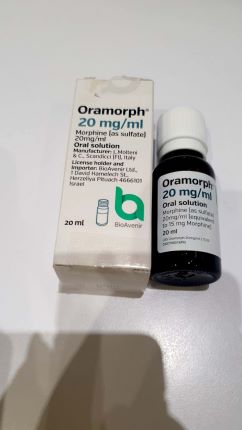Quest for the right Drug

אורמורפ 20 מ"ג / מ"ל ORAMORPH 20 MG/ML (MORPHINE AS SULFATE)
תרופה במרשם
תרופה בסל
נרקוטיקה
ציטוטוקסיקה
צורת מתן:
פומי : PER OS
צורת מינון:
תמיסה (פומי) : SOLUTION (ORAL)
עלון לרופא
מינוניםPosology התוויות
Indications תופעות לוואי
Adverse reactions התוויות נגד
Contraindications אינטראקציות
Interactions מינון יתר
Overdose הריון/הנקה
Pregnancy & Lactation אוכלוסיות מיוחדות
Special populations תכונות פרמקולוגיות
Pharmacological properties מידע רוקחי
Pharmaceutical particulars אזהרת שימוש
Special Warning עלון לרופא
Physicians Leaflet
Adverse reactions : תופעות לוואי
4.8 Undesirable effects In normal doses, the commonest side effects of morphine are nausea, vomiting, constipation and drowsiness and confusion. With chronic therapy, nausea and vomiting are unusual but should they occur the morphine dosage can be readily combined with an anti-emetic if required. Constipation may be treated with appropriate laxatives. For the evaluation of undesirable effects the following incidences are defined: Very common 1/10 Common 1/100 to < 1/10 Uncommon 1/1000 to < 1/100 Rare 1/10000 to < 1/1000 Very rare < 1/10000 Not known Can't be estimated from the available data Category Very Common Uncommon Not known Immune system Common Allergic reaction Anaphylactic reaction disorders Anaphylactoid reaction Psychiatric disorders Very Confusion Agitation Euphoria Drug dependence Morphine shows various common: Insomnia Hallucinations psychiatric undesirable mood Common: Mood altered Dysphoria effects which with changes, changes in regard to severity and mostly activity (mostly Very rare:dependence Thinking disturbances nature present differently euphoria, but sedation, but (see section 4.4), (depending on the also also enhanced decreased libido and personality and duration dysphoria activity or impaired potency of therapy). agitation), insomnia, alterations of cognitive and sensory functions (e. g. disturbances in thinking, altered apprehensivenes s/hallucinations, confusion) Nervous system Dizziness Convulsions Hyperalgesia (see section 4.4) disorders - Depending on Hypertonia Myoclonus Not known: hyperhidrosis the dose, morphine leads Headache Paraesthesia Especially in high doses to various extents of Syncope hyperalgesia or allodynia (see respiratory depression Very rare:tremor, section 4.4), which do not and sedation ranging Involuntary muscle involuntary muscle respond to a further increase in from slight fatigue to twitching, epileptic morphine doses (possibly dose contractions giddiness. seizures reduction or opioid rotation is necessary). Somnolence Eye disorders Visual disturbance Miosis, Miosis is a typical Very rare: blurred accompanying symptom vision, diplopia, nystagmus Ear and labyrinth Vertigo disorders Cardiac disorders Palpitations, Heart Uncommon: clinically failure relevant decrease or increase in blood pressure and heart rate Facial flushing, palpitations, generalised weakness up to loss of consciousness and heart failure can occur. Bradycardia Tachycardia Vascular disorders Facial flushing Hypertension Hypotension Respiratory thoracic and Bronchospasm Cough decreased mediastinal disorders Pulmonary oedema Respiratory depression Very rare: dyspnoea Non-cardiogenic pulmonary oedemas have been reported in patients treated under intensive-care conditions. Gastrointestinal Constipation Abdominal pain Dyspepsia Very rare: ileus, abdominal disorders Anorexia Dry pain Depending on the dose, Nausea mouth Vomiting Ileus nausea and dry mouth Common: can occur. vomiting Taste perversion Obstipation is a typical (especially at the Rare: elevation of accompanying symptom beginning of pancreatic enzymes of long-term treatment. therapy), and pancreatitis anorexia, respectively dyspepsia and taste alterations Hepatobiliary disorders Increased hepatic Biliary pain enzymes Exacerbation of pancreatitis Rare: biliary colics Very rare: elevation of liver-specific enzymes Skin and subcutaneous Hyperhidrosis Urticaria tissue disorders Rash Very rare: other skin reactions such as Common: exanthema and sweating, peripheral oedema hypersensitivity (reversible upon reactions such as termination of therapy) urticaria, pruritus Anaphylactic and anaphylactoid reactions can occur. Renal and urinary Common: Urinary retention Ureteric spasm disorders disturbances of Rare: renal colic micturition Reproductive system and Amenorrhoea breast disorders Decreased libido Erectile dysfunction General disorders and Asthenic Peripheral oedema Tolerance can develop. administration site conditions conditions Pruritus Rare: drug withdrawal (abstinence) syndrome Very rare: asthenia, malaise, chills, amenorrhoea Musculoskeletal and Very rare: muscle cramps, connective tissue muscle rigidity disorders Endocrine disorders Very rare: syndrome of inadequate ADH secretion (SIADH, with hyponatraemia as the main symptom). Very rare: Diplopia, nystagmus, Chills, Hyponatraemia. Drug dependence and withdrawal (abstinence) syndrome Use of opioid analgesics may be associated with the development of physical and/or psychological dependence or tolerance. An abstinence syndrome may be precipitated when opioid administration is suddenly discontinued or opioid antagonists administered, or can sometimes be experienced between doses. For management, see 4.4. Physiological withdrawal symptoms include: Body aches, tremors, restless legs syndrome, diarrhoea, abdominal colic, nausea, flu-like symptoms, tachycardia and mydriasis. Psychological symptoms include dysphoric mood, anxiety and irritability. In drug dependence, “drug craving” is often involved. Reporting of suspected adverse reactions Reporting suspected adverse reactions after authorisation of the medicinal product is important. It allows continued monitoring of the benefit/risk balance of the medicinal product. Any suspected adverse events should be reported to the Ministry of Health according to the National Regulation by using an online form /https://sideeffects.health.gov.il

מסגרת הכללה בסל
התוויות הכלולות במסגרת הסל
| התוויה | תאריך הכללה | תחום קליני | Class Effect | מצב מחלה |
|---|---|---|---|---|
| MORPHINE | ||||
| HYDROMORPHONE | ||||
| For the relief of severe pain in cancer. |
שימוש לפי פנקס קופ''ח כללית 1994
לא צוין
תאריך הכללה מקורי בסל
לא צוין
הגבלות
לא צוין
מידע נוסף
